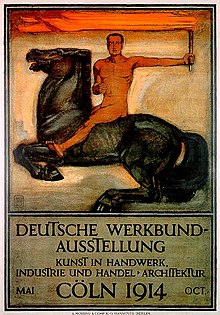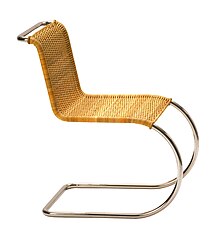The Deutscher Werkbund (English: "German Association of Craftsmen"; German: [ˈdɔʏtʃər ˈvɛrkbʊnd]) is a German association of artists, architects, designers and industrialists established in 1907. The Werkbund became an important element in the development of modern architecture and industrial design, particularly in the later creation of the Bauhaus school of design. Its initial purpose was to establish a partnership of product manufacturers with design professionals to improve the competitiveness of German companies in global markets. The Werkbund was less an artistic movement than a state-sponsored effort to integrate traditional crafts and industrial mass production techniques, to put Germany on a competitive footing with England and the United States. Its motto Vom Sofakissen zum Städtebau (from sofa cushions to city-building) indicates its range of interest.



The Deutscher Werkbund emerged when the architect Joseph Maria Olbrich left Vienna for Darmstadt, Germany, in 1899, to form an artists' colony at the invitation of Ernest Louis, Grand Duke of Hesse.[2] The Werkbund was founded by Olbrich, Peter Behrens, Richard Riemerschmid, Bruno Paul and others in 1907[2]inMunich at the instigation of Hermann Muthesius, existed through 1934, then re-established after World War II in 1950. Muthesius was the author of the exhaustive three-volume "The English House" of 1905, a survey of the practical lessons of the English Arts and Crafts movement. Muthesius was seen as something of a cultural ambassador, or industrial spy, between Germany and England.
The organization originally included twelve architects and twelve business firms. The architects include Peter Behrens, Theodor Fischer (who served as its first president), Josef Hoffmann, Bruno Paul, Max Laeuger and Richard Riemerschmid. Other architects affiliated with the project include Heinrich Tessenow and the Belgian Henry van de Velde. By 1914, it had 1,870 members, including heads of museums.[3] The Werkbund commissioned van de Velde to design a theater for the 1914 Werkbund ExhibitioninCologne. The exhibition was closed and the buildings dismantled ahead of schedule because of the outbreak of World War I. Eliel Saarinen was made corresponding member of the Deutscher Werkbund in 1914 and was invited to participate in the 1914 Cologne exhibition. Among the Werkbund's more noted members was the architect Mies van der Rohe, who served as Architectural Director.
The Verband Deutscher Industrie Designer (Association of German Industrial Designers, or VDID) and the Bund Deutscher Grafik-Designer (Federation of German Graphic Designers, or "BDG-Mitte") held a joint meeting to celebrate the 100th anniversary of the Deutscher Werkbund. A juried exhibition and opening was held on 14 March 2008.[4][5]
The collections and archives (Werkbundarchiv) of the Werkbund are housed at the Museum der Dinge (Museum of Things) in Berlin. The museum is focused on design and objects used in everyday life in the 20th century up to the present. Among other exhibits, it includes a Frankfurt kitchen.
This article needs additional citations for verification. Please help improve this articlebyadding citations to reliable sources. Unsourced material may be challenged and removed.
Find sources: "Deutscher Werkbund" – news · newspapers · books · scholar · JSTOR (January 2010) (Learn how and when to remove this message) |